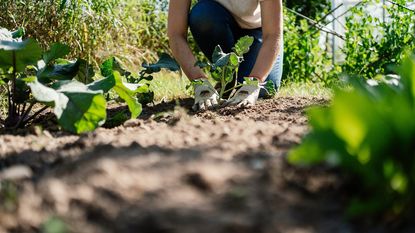Problems with Vegetables - 10 Mistakes In The Vegetable Garden


Have you ever had problems with vegetables growing in your garden? Do you have too many zucchinis, slug eaten lettuce, or over mature green beans? We've all been there. It doesn't matter if you're a first-year gardener or a seasoned grower, it's easy to make mistakes in the vegetable garden.
Mistakes in The Vegetable Garden
Here's a rundown of the 10 most common vegetable gardening mistakes and their solutions.
- Location, Location, Location: Picking the wrong spot to grow vegetables can lead to poor plant performance, difficulty watering, or neglecting chores. Solution: Choose an easily accessible site which receives six to eight hours of sunlight per day and drains well. If yard space is limited, try container or tower gardening methods.
- Rushing the Season: A beautiful spring day can trick gardeners into thinking it's safe to plant frost tender vegetables. Putting plants out too early or planting in the wrong season lowers yields and increases plant mortality rates. Solution: Follow planting guidelines on seed packets and plant tags.
- Crowd Control: With so many types and varieties of veggie plants and seeds available, it's easy to over buy and over plant. Crowding plants into the garden creates more competition for nutrients, hampers harvesting, and encourages disease and pests. Solution: Grab a sheet of graph paper and map out the garden. Then only buy what you have room to grow.
- Sprint Planting: Planting the garden in one day makes it easy to check this chore off the to-do list, but this leads to short harvest periods for many types of veggies like corn and beans. Solution: Instead of looking for creative ways to serve radishes for every meal, extend the harvest period by planting smaller rows of these crops every two weeks.
- Wildlife Freeloaders: Planting a row for the rabbits may seem like a good way to ensure sufficient harvests for your efforts, but wildlife rarely eat only the vegetables you earmark for them. Solution: Spend your efforts on putting up a fence, using a repellent spray, or intermingling undesirable plants with targeted ones.
- Weed it or Weep: Weeds create a myriad of problems with vegetables - everything from increased competition for nutrients and sunlight to harboring disease and pests. Solution: Weed frequently or use mulches like shredded paper, grass clippings, or straw which will decompose within one year.
- Faulty Feeding: Nutritious veggies come from nutrient-rich soil. Failure to feed or improperly feeding garden plants lowers yields and reduces produce quality. Solution: Incorporate plenty of organic compost into the garden soil or apply the correct type of fertilizer at the appropriate time.
- Moisture Madness: Too much or too little soil moisture levels make it difficult for garden plants to grow and produce optimal crops. Solution: Provide supplemental water when rainfall amounts are less than one inch (2.5 cm.) per week. Improve drainage by incorporating organic compost or raise garden beds.
- Feast or Famine: When other aspects of garden care are equal, unpredictable weather patterns can affect plant yields. Some years gardeners barely produce enough vegetables for table use, while other years they have bumper crops. Leaving this extra produce in the garden though encourages disease and pests. Solution: Give away, donate, or sell extra produce.
- Autumn Abandonment: Failure to remove discarded vegetables and plant materials at the end of the season provides a perfect environment for the propagation of both plant diseases and pests. Solution: Make it a habit to clean off the garden at the end of the gardening season. Resist putting weeds and diseased plant material in the compost bin.
Gardening tips, videos, info and more delivered right to your inbox!
Sign up for the Gardening Know How newsletter today and receive a free download of our most popular eBook "How to Grow Delicious Tomatoes."

Laura Miller has been gardening all her life. Holding a degree in Biology, Nutrition, and Agriculture, Laura's area of expertise is vegetables, herbs, and all things edible. She lives in Ohio.
-
 Want a Backyard Mini Orchard? Create Your Own Container Orchard
Want a Backyard Mini Orchard? Create Your Own Container OrchardEasier to care for in small spaces, a backyard mini-orchard makes sense for busy gardeners and juicy fruit is the reward.
By Teo Spengler
-
 Urban Beekeeping Guide: Top Tips For Raising Bees In The City
Urban Beekeeping Guide: Top Tips For Raising Bees In The CityUrban beekeeping can be a rewarding and appreciated pastime, but first be sure it’s legal in your city and learn the ropes of beekeeping.
By Mary Ellen Ellis